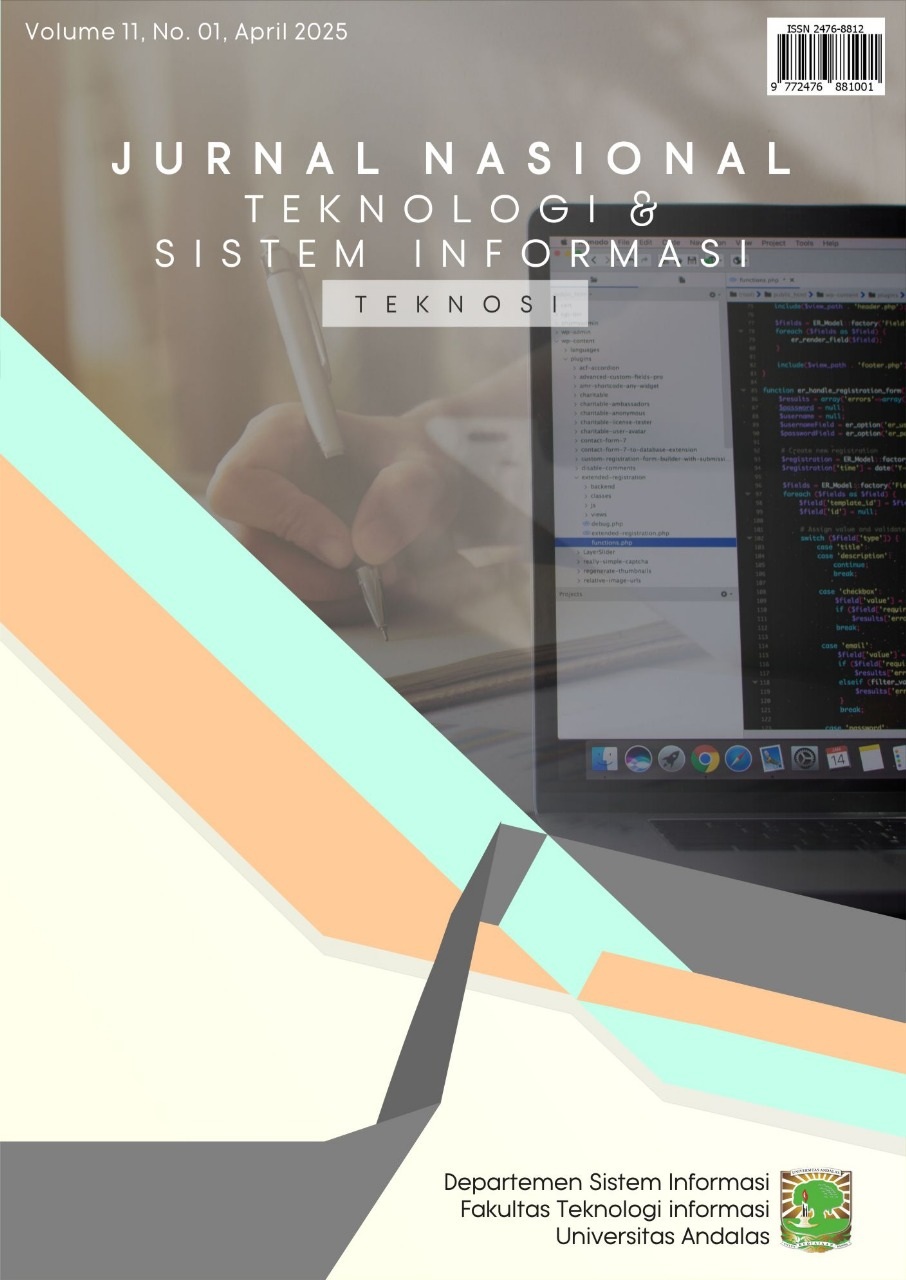Evaluasi Model Prediksi Curah Hujan Berbasis Machine Learning di Kota Bandung
DOI:
https://doi.org/10.25077/TEKNOSI.v11i2.2025.136-143Keywords:
Model Prediksi, Random Forest, Logistic Regression, Extreme Gradient BoostingAbstract
Model prediksi curah hujan berbasis machine learning bertujuan untuk memberikan prediksi curah hujan harian yang akurat. Penelitian ini membandingkan kinerja beberapa algoritma machine learning yang digunakan untuk membangun model prediksi kejadian hujan di Kota Bandung, yaitu Logistic Regression, Random Forest, dan Extreme Gradient Boosting. Evaluasi model prediksi dilakukan dengan menganalisis nilai accuracy, precision, recall, F1 score, dan AUC. Hasilnya menunjukkan bahwa ketiga model tersebut dapat memprediksi kejadian hujan harian di Kota Bandung secara efektif. Namun, model Random Forest secara umum menunjukkan performa terbaik dengan akurasi prediksi mencapai 85% sehingga model ini direkomendasikan untuk digunakan dalam memprediksi kejadian hujan guna mendukung pengambilan keputusan dan perencanaan kegiatan di Kota Bandung.References
Z. A. Dwiyanti and C. Prianto, “Prediksi Cuaca Kota Jakarta Menggunakan Metode Random Forest,” J. Tekno Insentif, vol. 17, no. 2, pp. 127–137, 2023, doi: 10.36787/jti.v17i2.1136.
A. Sharma and V. Vijayakumar, “on Cloud Systems EAI Endorsed Transactions Predictive Analytics in Weather Forecasting using Machine Learning Algorithms,” pp. 1–4, 2019, doi: 10.4108/eai.7-12-2018.159405.
S. D. Latif et al., “Assessing Rainfall Prediction Models: Exploring the Advantages of Machine Learning and Remote Sensing Approaches,” Alexandria Eng. J., vol. 82, no. May, pp. 16–25, 2023, doi: 10.1016/j.aej.2023.09.060.
O. A. Wani et al., “Predicting Rainfall Using Machine Learning, Deep Learning, and Time Series Models Across an Altitudinal Gradient an The North-Western Himalayas,” Sci. Rep., vol. 14, no. 1, 2024, doi: 10.1038/s41598-024-77687-x.
R. Farikhul Firdaus and I. V. Paputungan, “Prediksi Curah Hujan di Kota Bandung Menggunakan Metode Long Short Term Memory,” J. Penelit. Inov., vol. 2, no. 3, pp. 453–460, 2022, doi: 10.54082/jupin.99.
A. N. Sallamah, A. Sunandar, A. M. Rizka, and C. Rozikin, “Prakiraan Cuaca Kota Bandung di Tahun Berikutnya dengan Menggunakan Metode Naïve Bayes,” DoubleClick: Journal of Computer and Information Technology, vol. 8, no. 1, pp. 27–32, 2024.
http://e-journal.unipma.ac.id/index.php/doubleclick
D. M. Nanda, T. H. Pudjiantoro, and P. N. Sabrina, “Metode K-Nearest Neighbor (KNN) dalam Memprediksi Curah Hujan di Kota Bandung,” Semin. Nas. Tek. Elektro, Sist. Informasi, dan Tek. Inform., pp. 387–393, 2022, doi: 10.31284/p.snestik.2022.2750
R. Torhino and P. N. Andono, “Penerapan Algoritma Random Forest dalam Prediksi Curah Hujan untuk Mendukung Analisis Cuaca,” Building of Informatics Technology and Science (BITS), vol. 6, no. 3, PP. 1688-1699, 2024, doi: 10.47065/bits.v6i3.6404.
A. Fauziah, H. Hermanto, and M. A. Sukmarini, “Extreme Gradient Boosting pada Peramalan Pola Curah Hujan Bulanan Kabupaten Banyuwangi,” J. Kridatama Sains Dan Teknol., vol. 6, no. 02, pp. 430–440, 2024, doi: 10.53863/kst.v6i02.1154.
S. M. Gowtham, Y. S. Ganesh, and M. M. Ali, “Efficient Rainfall Prediction and Analysis using Machine Learning Techniques,” Turkish J. Comput. Math. Educ. vol. 12, no. 6, pp. 3467–3474, 2021.
S. R. Vinta and R. Peeriga, “Rainfall Prediction using XGB Model with the Australian Dataset,” EAI Endorsed Trans. Energy Web, vol. 11, no. April, pp. 1–4, 2024, doi: 10.4108/ew.5386.
C. M. Liyew and H. A. Melese, “Machine Learning Techniques to Predict Daily Rainfall Amount,” J. Big Data, vol. 8, no. 1, 2021, doi: 10.1186/s40537-021-00545-4.
H. N. Irmanda, Ermatita, M. K. Awang, and M. Adrezo, “Enhancing Weather Prediction Models through the Application of Random Forest Method and Chi-Square Feature Selection,” Int. J. Informatics Vis., vol. 8, no. 3–2, pp. 1506–1514, 2024, doi: 10.62527/joiv.8.3.2356.
R. Ridwan, E. H. Hermaliani, and M. Ernawati, “Penerapan: Penerapan Metode SMOTE untuk Mengatasi Imbalanced Data pada Klasifikasi Ujaran Kebencian,” Comput. Sci., vol. 4, no. 1, pp. 80–88, 2024, doi: 10.31294/coscience.v4i1.
N. P. Y. T. Wijayanti, E. N. Kencana, and I. W. Sumarjaya, “Smote: Potensi dan Kekurangannya pada Survei,” E-Jurnal Mat., vol. 10, no. 4, p. 235, 2021, doi: 10.24843/mtk.2021.v10.i04.p348.
R. Praveena, T. R. G. Babu, M. Birunda, G. Sudha, P. Sukumar, and J. Gnanasoundharam, “Prediction of Rainfall Analysis Using Logistic Regression and Support Vector Machine,” J. Phys. Conf. Ser., vol. 2466, no. 1, 2023, doi: 10.1088/1742-6596/2466/1/012032.
M. Y. Khan, A. Qayoom, M. S. Nizami, M. S. Siddiqui, S. Wasi, and S. M. K. Raazi, “Automated Prediction of Good Dictionary EXamples (GDEX): A Comprehensive Experiment with Distant Supervision, Machine Learning, and Word Embedding-Based Deep Learning Techniques,” vol. 2021, 2021, doi: 10.1155/2021/2553199.
Z. Faska, L. Khrissi, K. Haddouch, and N. El Akkad, “A Robust and Consistent Stack Generalized Ensemble Learning Framework for Image Segmentation,” J. Eng. Appl. Sci., vol. July, 2023, doi: 10.1186/s44147-023-00226-4.
D. T. Wilujeng, M. Fatekurohman, and I. M. Tirta, “Analisis Risiko Kredit Perbankan Menggunakan Algoritma K-Nearest Neighbor dan Nearest Weighted K-Nearest Neighbor,” Indones. J. Appl. Stat., vol. 5, no. 2, p. 142, 2023, doi: 10.13057/ijas.v5i2.58426.
N. A. P. Indaryono, R. Saedudin, and F. Hamami, “Analisa Perbandingan Algoritma Random Forest dan Naïve Bayes untuk Klasifikasi Curah Hujan Berdasarkan Iklim di Indonesia”, JIPI Jurnal Ilm. Penelit. dan Pembelajaran Inform., vol. 9, no. 1, pp. 158–167, 2024, doi: 10.29100/jipi.v9i1.4421.
Downloads
Submitted
Accepted
Published
How to Cite
Issue
Section
License
Copyright (c) 2025 Jurnal Nasional dan Sistem Informasi

This work is licensed under a Creative Commons Attribution-ShareAlike 4.0 International License.
Hak cipta untuk artikel ini ditransfer ke Jurnal Nasional Teknologi dan Sistem Informasi (TEKNOSI) jika dan ketika artikel diterima untuk publikasi. Yang bertanda tangan di bawah ini dengan ini mentransfer setiap dan semua hak di dalam dan ke kertas termasuk tanpa batasan semua hak cipta untuk TEKNOSI. Yang bertanda tangan di bawah ini dengan ini menyatakan dan menjamin bahwa makalah tersebut asli dan bahwa ia adalah pembuat makalah, kecuali untuk bahan yang secara jelas diidentifikasi sebagai sumber aslinya, dengan pemberitahuan izin dari pemilik hak cipta jika diperlukan. Yang bertanda tangan di bawah ini menyatakan bahwa ia memiliki kekuatan dan wewenang untuk membuat dan melaksanakan penugasan ini.
Kami menyatakan bahwa:
- Makalah ini belum diterbitkan dalam bentuk yang sama di tempat lain.
- Makalah ini tidak akan dikirimkan di tempat lain untuk publikasi sebelum penerimaan/penolakan oleh Jurnal ini
- Izin hak cipta diperoleh untuk materi yang diterbitkan di tempat lain dan yang memerlukan izin ini untuk reproduksi.
Selanjutnya, Saya/kami dengan ini mentransfer hak publikasi yang tidak terbatas dari makalah yang disebutkan di atas secara keseluruhan kepada TEKNOSI. Transfer hak cipta mencakup hak untuk mereproduksi dan mendistribusikan artikel, termasuk cetak ulang, terjemahan, reproduksi foto, mikroform, bentuk elektronik (offline, online) atau reproduksi lain yang serupa.
Penulis yang sesuai menandatangani dan menerima tanggung jawab untuk merilis materi ini atas nama setiap dan semua penulis bersama. Perjanjian ini harus ditandatangani oleh setidaknya salah satu penulis yang telah memperoleh persetujuan dari rekan penulis jika berlaku. Setelah pengajuan perjanjian ini ditandatangani oleh penulis yang sesuai, perubahan kepengarangan atau dalam urutan penulis yang tercantum tidak akan diterima.
Hak / Syarat dan Ketentuan yang dipertahankan :
- Penulis memiliki semua hak kepemilikan dalam setiap proses, prosedur, atau artikel manufaktur yang dijelaskan dalam Karya ini.
- Penulis dapat mereproduksi atau mengotorisasi orang lain untuk mereproduksi karya ini atau karya turunannya untuk penggunaan pribadi penulis atau untuk penggunaan perusahaan, dengan ketentuan bahwa sumber dan menyatakan hak cipta dimiliki TEKNOSI, salinan tidak digunakan dengan cara apa pun yang menyiratkan pengesahan TEKNOSI atas suatu produk atau layanan dari pihak mana pun, dan salinannya sendiri tidak ditawarkan untuk dijual.
- Meskipun penulis diizinkan untuk menggunakan kembali semua atau sebagian dari karya ini dalam karya lain, ini tidak termasuk mengabulkan permintaan pihak ketiga untuk mencetak ulang, menerbitkan ulang, atau jenis penggunaan ulang lainnya.
















